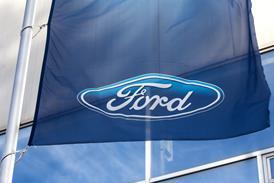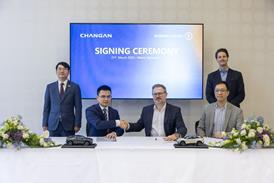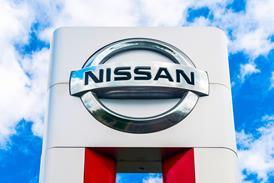Despite some recent legislative wins on permissible overhangs, rig length and adaptable trailers, the US car-carrier sector continues to face a number of operational challenges, including a capacity squeeze, more demanding customers and downward price pressure
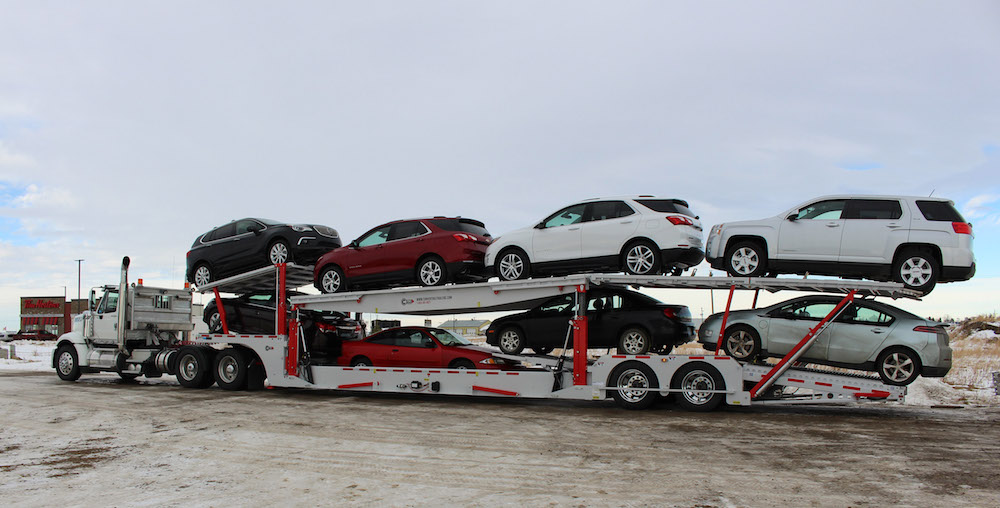 Just over a year ago, Robert Farrell of the American Trucking Associations (ATA) was celebrating the inclusion of three key automotive transport initiatives in a US government spending bill signed into law in March 2018. As executive director of the ATA’s Automobile Carriers Conference (ACC), Farrell regularly coordinates lobbying efforts between the US House of Representatives and Senate, as well as related government oversight agencies, on issues pertaining to the transport of finished vehicles by truck.
Just over a year ago, Robert Farrell of the American Trucking Associations (ATA) was celebrating the inclusion of three key automotive transport initiatives in a US government spending bill signed into law in March 2018. As executive director of the ATA’s Automobile Carriers Conference (ACC), Farrell regularly coordinates lobbying efforts between the US House of Representatives and Senate, as well as related government oversight agencies, on issues pertaining to the transport of finished vehicles by truck.
The three breakthroughs achieved have helped automotive hauliers to reclaim much of the capacity the sector has lost over the past 15 years.
The capacity squeeze in car-carrying equipment began in the early 2000s when the US government’s Environmental Protection Agency enforced a multi-stage mandate calling on the trucking industry to reduce nitrogen oxide emissions by 90% over roughly a decade. The resulting updates to engine configurations and exhaust treatment systems would not only increase the weight of trucks but result in changes to their configuration that meant moving less cargo.
Space has always been at a premium on car-carriers, but in addition to these new regulations, changes in the market itself have also squeezed capacity – most notably the growth in sales of SUVs and pickup trucks in recent years, compared with more traditional vehicles.

“A number of factors have contributed to reductions in load factor and the shift to light trucks and SUVs is only one of them. Emissions regulations have increased the weight and length of tractors. In addition, OEMs have shifted to using straps rather than chains, releasing [greater] movement of the suspension and requiring more room between vehicles.
“You also have hybrids and electrics that weigh significantly more than gasoline-powered vehicles,” comments Kathleen McCann, executive chair of United Road and a member of the ACC board of directors. “All these factors combined have created a 10-15% reduction in load factor – in essence, requiring 10-15% more trucks on the road today than would have historically been required.”
Stringent regulations
Automotive hauliers in the US have to meet some of the most stringent regulations on vehicle configuration and load movement, making what Farrell and the ACC accomplished seem quite significant.
The ACC succeeded in getting changes to permissible overhangs to allow for four vehicles to be loaded on the front section of a car carrier with six at the back, from three in the front and four in the rear. It also lobbied to secure an additional 5ft (1.5 metres) in the length of a rig to a maximum of 80ft. Along with the potential for one additional vehicle to be carried, this allows for more space between the units, cutting down on the potential for damage.
Farrell and the ACC also lobbied successfully to allow adaptable trailers to operate in the US market. Adaptable trailers – for example, those that can be turned from car-carriers into flatbeds suitable for more general cargo – provide the flexibility to find non-automotive backloads, reducing the longstanding problem of empty running (see interview with Bill Pawluk below).
In a fourth area in which the ACC was lobbying, its efforts were less successful, however – namely its attempt to secure a maximum weight variance for a limited distance at the start of a fully-loaded run. Congress did not warm to the initial proposal of a 10% increase, admits Farrell.
 “We didn’t get that fourth one and with Congress you get one shot, not four separate shots,” he comments. “But we made the weight allowance the thrust of our most recent call on Washington.”
“We didn’t get that fourth one and with Congress you get one shot, not four separate shots,” he comments. “But we made the weight allowance the thrust of our most recent call on Washington.”
In late February, Farrell and his colleagues went to Washington for a round of visits with Congressional leaders to consider a new proposal that would provide automobile truck transporters with a 5% variance on gross weight. An increase to 84,000 pounds (just over 38 tonnes) within a certain radius of being fully loaded would provide the flexibility to add one more car to the load, he explains.
Farrell says the ACC’s successes during the last year have helped car-carriers regain much of the capacity lost as a result of recent shifts in regulation and consumer preferences. But despite this success and the continuing effort to achieve the weight variance initiative to secure additional capacity for each load, he says, the sector still faces challenges.
“When you look at these issues, one of the things I worry about in the future is what’s technology going to do? What’s coming down the road in future trucks? What future mandates may manufacturers put upon us?”
Price pressures
Sarah Amico, executive chair of Jack Cooper Holdings and an ACC board member, observes that car hauling is “a really brutal industry” that is facing downward price pressure “in many instances”, meaning the need to replace old and worn-out equipment occurs under difficult circumstances.
“If you think about that dynamic going face-to-face with the dynamic that OEMs almost always want a price decrease of some sort from suppliers, this is the immovable object and the unstoppable force,” she states. Nonetheless, she offers a number of possible solutions.
“Number one, I think OEMs are going to have to be realistic about what the cost inputs are. It’s not just about the price they can get today, but what’s the stability and the overall carrier base and supply chain, and how does that work over the long term?” says Amico. “We saw, in the last downturn, the number of carriers who went bust, partially because they had faced perpetual downward price pressure. That’s a really tough environment for reinvesting in their fleet, and they were just getting by on skinny margins. The minute there was a downturn, they went under.
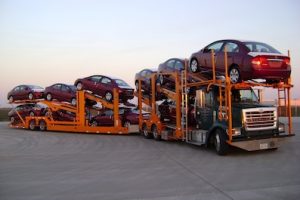 “Number two, I really think that we’re going to have to see if there are ways to be more efficient in a manner that’s win-win for the carrier and the customer… The way we’ve looked at it is maybe it doesn’t have to just be convertible trailers or multipurpose trailers for inbound-outbound automotive parts. What if it’s just other [wheeled] freight?” As an example, she explains that besides cars, Jack Cooper moves John Deere tractors and Polaris ATVs, which helps reduce empty miles.
“Number two, I really think that we’re going to have to see if there are ways to be more efficient in a manner that’s win-win for the carrier and the customer… The way we’ve looked at it is maybe it doesn’t have to just be convertible trailers or multipurpose trailers for inbound-outbound automotive parts. What if it’s just other [wheeled] freight?” As an example, she explains that besides cars, Jack Cooper moves John Deere tractors and Polaris ATVs, which helps reduce empty miles.
“We thought we’d get creative about building the efficiency in these networks. I think if we can do that, we can at least maintain costs or prevent massive price increases to the customers while also not being forced to effectively tell people in a really tight labour market, ‘I’m sorry. Our customers want price decreases, you’re just going to have to take a cut.’ That’s not real life in this economy,” she states.
Battling rail congestion
According to Amico, the chronic lack of investment by rail companies in their own equipment, combined with changes in the market and low fuel prices, is providing opportunities for extra business for car hauliers on runs of 400 miles or less.
“For years now, railroads have under-invested in bi-levels. So, there’s capacity which traditionally has been on trains going on trucks, or at least getting bids from trucks,” says Amico. “A relatively small shift in off-rail volume is a meaningful increase in the addressable market on the car-haul trucking side. They don’t have to lose very much for our industry to gain a lot of opportunity. That’s probably, at an industry level, what I think is most interesting about the consumer trend of heavier, larger SUVs and trucks right now.
“We’d love to see more [volume], but we also know that the rail operators are important partners for us, especially in locations like railheads,” she adds. “We’re certainly going to work on the assumption that we need to be available and will have capacity – a properly maintained fleet to be able to jump in, if and when the dynamics change – and the OEMS need more help off rail.”
Farrell notes the ATA is making an effort to tackle rail congestion. “We’re trying to [have] a dialogue with the railroads in certain areas to work together efficiently to increase the velocity of the vehicles in and out of a rail yard. In some instances, it’s working. Some rail yards are going to bring in their off-loaders, off-loading the rail cars at night. And when it comes first thing in the morning, when we’re there, we can have cars from day one in dispatch. That increases the velocity and the flow at the rail facility.”
Implementing ELDs
Automotive hauliers have also had to face the implementation of electronic logging devices (ELDs) recently, which were required in all Class 8 trucks by April 1 last year after a December 2017 deadline extension. As in other truck sectors, there appears to have been a divide between the experiences of large carriers and smaller ones on this score.
Large fleets report that the transition from paper logs to ELDs has been essentially painless and quite smooth. Legacy onboard communications systems, many with the latest advancements, made the ELD switch a non-event for carriers of significant size. And while most operations going from paper to e-logs experienced a tightening of available time and a loss of productivity, Amico says Jack Cooper’s union operation is set under a contract that withstood any losses in time or earnings for drivers.

The most significant impact of the ELD transition in the finished vehicle sector has been among smaller operations. David Fleischman, sales manager for TEC Equipment, says there was a last-minute rush of smaller carriers and single owner-operators purchasing ELD monitoring devices. Since then, he adds, drivers forced to operate without the flexibility paper logs provided have become more focused than ever before on their use of time.
“Electronic logs are definitely making their impact in our industry, and what’s really interesting from our standpoint is that we’re seeing driver behaviours change, especially owner-operators,” he comments. “Before, they were happy to stop at the truckstop and visit their friends, or take an extended rest. Now they don’t have time to sit and talk and have coffee for half the day. They want to come in and take care of the business they need to take care of.
“If their truck needs a repair, they are trying to make sure that happens when they’re on a 34-hour reset. And if they’re not on a 34-hour reset, there is a lot of pressure on our shops to get those trucks repaired and out.”
One of the initial impacts of ELDs has been in the steps that have been taken by the Federal Motor Carrier Administration to update the existing hours of service (HOS) regulations. The agency’s notice of proposed rulemaking included a public comment period that collected more than 5,200 remarks prior to closing in September last year. This issue is being watched by numerous industry stakeholders.
“We’ll follow any hours of service changes or proposals of the DOT that FMCSA is looking at, and we supported the ATA’s comments,” says Farrell of the public comments ATA submitted to FMCSA’s docket. “When the agency comes back and says ‘now we’re thinking of doing something specific’, we’ll definitely take a look at it as it affects the auto transporter segment of the industry, and we’ll file comments accordingly.”
McCann is optimistic that the review by the FMCSA of the rules governing hours of service could be a positive for the automotive haulage sector. “There is opportunity for sensible refinement of HOS regulations now that data is available, and the auto haulers are working closely with the ATA to advance change,” she says.
“We are also grateful for the recent FMCSA ruling that prevented states from establishing separate meal and rest break rules, which caused significant disruption and wasted hours for our car haulers with zero safety benefit.”
Political machinations
The 2018 US mid-term elections delivered a House of Representatives that is now controlled by the Democrats, who are currently seen as being less inclined to roll back regulation than Republicans.
When assessing what could play well within a now divided legislative branch of government, Farrell takes a pragmatic approach. He still believes it’s possible for the ACC to obtain the desired weight allowance variance, especially after revising the proposal down to 5% and a gross total weight of 84,000 pounds. In his view, the change in the House may actually open doors for issues that are important to the ACC and trucking in general.
“First of all, when you look back, it was the Democrats who pushed deregulation, not the Republicans. So we have a Democratic Congress. The House Ways and Means Committee held a hearing [in March] on transportation funding,” he explains. “The new Democratic House has created a special sub-committee focused specifically on finding the money to fund a transportation bill. Democrats like to spend money.

“At ATA, we were advocating a 20 cent increase in the diesel tax with the last Congress, which was controlled by the Republicans. A five cent increase per year (over four years) brings in $38 billion per year for $380 billion over ten years. And that amount is over and above what we currently bring in under the diesel fuel tax for the Highway Trust Fund,” he says.
“In the last Congress, Republicans would not even consider raising the fuel tax. They signed a pledge for no taxes. [Republicans] can’t raise the fuel tax, but you need money for the infrastructure.”
In Farrell’s view, infrastructure may be the single bipartisan issue that can cut through the massive divisions currently in Washington.
“We have a divided government and the Democrats in the House are showing that they want to investigate and not particularly legislate. I think the only thing they can legislate around that with is a bipartisan bill. And the bipartisan bill that has any chance of ending up on the president’s desk is an infrastructure bill,” Farrell states. “We feel now’s the time. We’ll see what happens – we’ll see if they can get it done. That’s one reason why I brought my members here in early March.”
What inspired you to pursue a new approach to automotive logistics?
I began this journey when I became an owner-operator 30 years ago, when I first learned to transport automobiles in western Canada. From day one, I was amazed at how many empty miles I drove simply because vehicles were not always available in the lanes I travelled.
Running empty serves no purpose. As a matter of fact, it is detrimental not just to the individual running empty, but to society. Putting emissions into the air in a closed ecosystem and consuming non-renewable resources can only work for a little while before our atmosphere becomes irreparably changed. The present way of doing business cannot continue perpetually; it is not sustainable.
The equipment I was operating was fully capable of doing more work on the normally empty returns, but it could not convert into a useful and commercially acceptable configuration. After studying the conventional single-purpose, auto-carrier designs, I found a way that could serve both purposes – autos and general flat-deck freight. After eight months of engineering and prototyping, I developed our very first convertible auto carrier system in 1999.
What are the benefits of your new model versus the traditional method of car hauling?
Simply put, when you are done hauling cars at your destination and there are no cars to haul back, within one or two minutes of hydraulic manipulation the upper decks collapse onto the lower deck, creating a flat deck configuration that can lend itself to multiple types of flat deck transportation applications. Granted, our weight-hauling capacity is typically reduced by about 15% due to the weight of hydraulics, but an 85% weight load factor is much better than running empty.
What were the design challenges you faced?
We had many challenges along the way. How do you design an outside-frame rail trailer system that can carry enough point-load weight of general freight to make it an acceptable system? We needed to understand what types of steel to use that could bear the requirements we needed – 1,000 pounds per foot of deck. It is easy to carry such a point load with a conventional flat deck design but when hauling automobiles, stacking vehicles over top of each other makes your finished height very high, often beyond regulatory restrictions.
How could we design a trailer that could bring finished vehicle heights down to regulation, maintain or improve load factor and provide a commercially acceptable flat deck configuration that would enable the operator to earn revenue on the normally empty run? These were the challenges back when I started this 20 years ago. Today, after having solved most of these issues, we are now focusing on cost reduction and scale-up of production.
What regulations did you have to meet?
Not only did we need to meet government regulations, we were directly involved in the actual changes. We always tried to comply with government regulatory standards, but, when you are innovating something that has never existed before, sometimes regulation does not even exist to provide guidance. This happened in the US, China and India. We continue to work with these regulatory bodies to amend and improve their present regulations to accommodate something that will improve transportation efficiencies in their respective environments.
What has been the reaction of the market?
When discussing the idea of convertible solutions, theoretically it is easy to get people to understand how it can be of benefit. Where we run into problems is the implementation of our convertible solutions. The auto logistics industry is entrenched in legacy-style processes and habits that are difficult to reconfigure.
The automotive industry is a fast-paced, highly specialised industry, with high expectations. Stopping these processes to change direction is where everyone hesitates. They have time constraints on the delivery of vehicles to the customer. They need to do this without damage and in mass quantities. These are simple and understandable requirements. To introduce general freight into the equation adds complexity and risk that conventional thinking does not understand.
Everyone is busy doing the same old thing that continues to pay them their money. Auto haulers do not know much about general freight and general freight haulers do not know much about hauling cars. These two verticals have never collaborated simply because they have never had the equipment with which to do it. Now we have the equipment and we will be introducing convertible systems, solutions and processes that can make empty miles a thing of the past.
Dedicated software that takes into account the needs of both verticals is essential to compete efficiently in today’s competitive and highly technical world. The full magnitude of this undertaking has never been fully understood until now. We are about to bring change into this industry around the world where all stakeholders will see benefit from this innovation.










